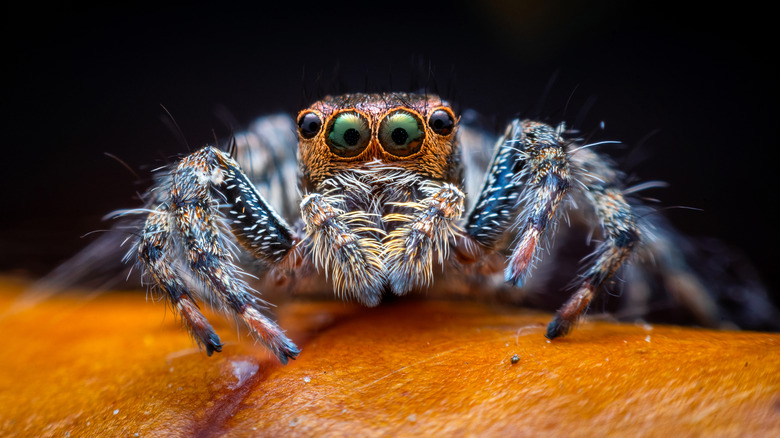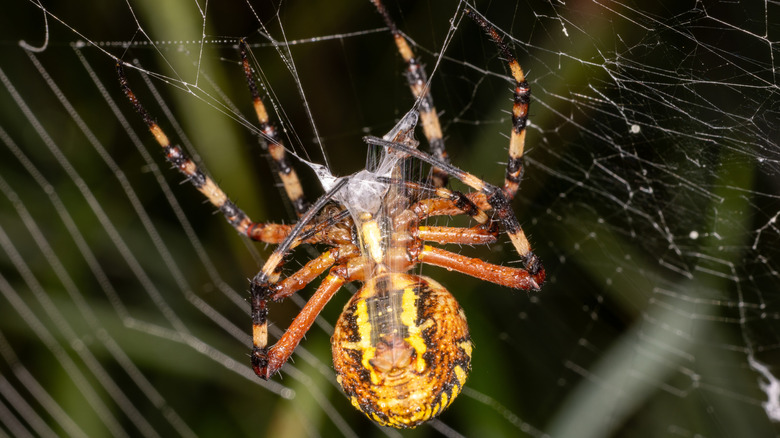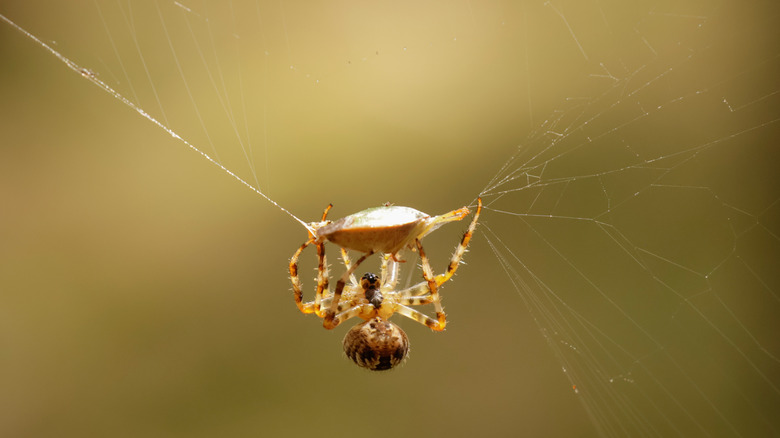The Truth About How Much Spiders Eat Every Year
As undesirable as it might be, we're pretty much surrounded by spiders at all times, and if the arachnids' generally unsettling appearance wasn't enough to make that a vertiginous thought, consider that these creatures eat so much annually that they could — as the Washington Post so eagerly put it — eat every human on Earth in one year. Fortunately, spiders don't particularly like feasting on human flesh, otherwise we really would have a problem on our hands. They do, however, absolutely love devouring insects, which when you think about it makes the fact that spiders are everywhere around us a little more easy to take.
A 2017 study published in the The Science of Nature aimed to document the impact of spiders on insects worldwide and produced estimates which state that spiders kill between 400 and 800 million metric tons of prey every year. Not only does that make spiders an extremely important predator group in terms of the world's ecosystem balance, it means we're all essentially benefitting from a guaranteed form of pest control.
It also provides a striking insight into just how many spiders there actually are in the world and how successful they are as predators. As the researchers in this study noted, the estimate of between 400 and 800 metric tons means spiders essentially kill as much if not more prey than whales in the world's oceans every year. Whales are thought to kill between 280 and 500 million tons of prey annually, which means arachnids might just be casually killing off enough insects every year to outdo the biggest fish in the world.
Spiders eat more weight annually than the entire human population of Earth
To reach their estimates, a team of researchers carried out calculations based on the total estimated biomass of spiders globally (around 25 million metric tons according to the authors) and their food requirements per unit body weight. A second method involved assessing the spiders' annual prey kill based on field censuses and web density estimates. All these approaches were entirely independent, providing two calculations for the annual prey kill of spiders based on separate data. In other words, the study, entitled "An estimated 400–800 million tons of prey are annually killed by the global spider community" provides pretty compelling evidence for the figures it puts forward.
Those figures are striking, too. If the comparison with whales wasn't enough to convey just how much prey spiders are killing every year, consider that humans are thought to eat around 400 million tons of meat and fish annually. Similarly, the entire seabird population of the world is estimated to kill 70 million tons of prey every year. Spiders — those small arthropods that hide in the cracks of our homes — are potentially dispatching almost 12 times that much annually. If you really want to creep yourself out, consider that all humans on Earth weigh around 390 million metric tons, which means spiders are eating more weight every year than the entire human population of our planet. So, what exactly are these things eating to put up such wildly impressive numbers?
What do spiders actually eat?
According to the study, spider prey is limited to less than 10 arthropod orders: Diptera, Hemiptera, Hymenoptera, Collembola, Coleoptera, Lepidoptera, Orthoptera, and Araneae — and yes, that last one means spiders are eating their own kind. Interestingly enough, spiders that exist in warmer areas tend to eat more fellow spiders than those in colder climates, while those arachnids that actively hunt food (rather than spinning webs and waiting) also feed on their own kind more than web-builders.
Otherwise, these alarmingly efficient predators don't discriminate too much when it comes to their food, devouring eggs and both young and adult insects. As the researchers point out, some arachnids also feast on earthworms, slugs, snails, and even small vertebrates such as frogs, snakes, and lizards — though this is rare. The Goliath birdeater — the largest spider in the world by mass — has been known to live up to its name, but again, it's a rare occurrence for this species to actually dine on birds. Still, it all adds up to spiders' impressive and slightly unsettling annual prey kill total.
In the study, the researchers did note that forest- and grassland-based spiders accounted for more than 95% of the prey killed every year, which means that most of the insects dying by spiders aren't in our homes. But that has more to do with the availability of prey and lack of human intervention in natural environments than it does with home-dwelling spiders being lazy or inefficient. Considering pests and disease carriers breed in these forest and grassland environments, it's also an undeniable positive that spiders are helping control those populations.


